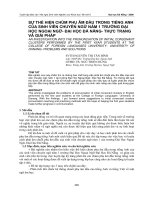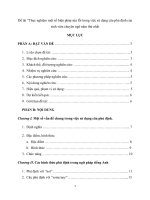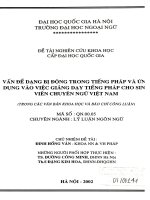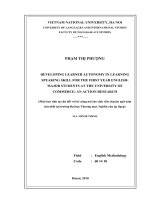SỬ DỤNG KỸ THUẬT TONGUE TWISTER ĐỂ NÂNG CAO KỸ NĂNG PHÁT ÂM TIẾNG ANH CHO SINH VIÊN CHUYÊN NGỮ NĂM THỨ NHẤT TẠI TRƯỜNG ĐẠI HỌC SƯ PHẠM – ĐẠI HỌC THÁI NGUYÊN
Bạn đang xem bản rút gọn của tài liệu. Xem và tải ngay bản đầy đủ của tài liệu tại đây (244.24 KB, 4 trang )
<span class='text_page_counter'>(1)</span><div class='page_container' data-page=1>
ISSN: 1859-2171
<i>e-ISSN: 2615-9562 </i> TNU Journal of Science and Technology 225(03): 189 - 192
<i>; Email: </i> 189
<b>USING TONGUE TWISTER TECHNIQUE TO IMPROVE ENGLISH </b>
<b>PRONUNCIATION FOR THE FIRST-YEAR ENGLISH MAJOR STUDENTS </b>
<b>AT THAI NGUYEN UNIVERSITY OF EDUCATION </b>
<b>Vu Dinh Bac1*<sub>, Hoang Thi Hong Hanh</sub>2<sub>, Doan My Hanh</sub>1 </b>
<i>1<sub>TNU - University of Education, </sub>2<sub>Thai Nguyen University </sub></i>
ABSTRACT
Currently, English has been used as an international language by people all over the world. In
Vietnam, English is taught from primary schools or even from kindergarten to university; however,
there are numerous Vietnamese students still find it is hard to speak English well. Especially, many
Vietnamese first-year English majors often feel confused in pronouncing because of some
inappropriate approaches or techniques. Thus, the aim of this study is to find out the result of using
the tongue twister technique to help students improve their pronunciation. The participants of this
study are first-year English major students at Thai Nguyen University of Education. Through the
application of the student's practical approaches, the study found out the current state of using tongue
twisters technique in learning pronunciation and the effectiveness of using tongue twister technique
to enhance students’ pronunciation skills at Thai Nguyen University of Education. Classroom
observation checklist,pre-test and post-test were employed as data collection instrument with the
purpose of achieving data for the study. The findings of the study will be useful for both teachers and
students’ English speaking teaching and learning at Thai Nguyen University of Education in
particular as well as all of the universities in general.
<i><b>Key words: tongue twister; pronunciation skills; pronunciation analysis; first – year English </b></i>
<i>major; Thai Nguyen University of Education </i>
<i><b>Received: 10/3/2020; Revised: 26/3/2020; Published:29/3/2020 </b></i>
<b>SỬ DỤNG KỸ THUẬT TONGUE TWISTER ĐỂ NÂNG CAO KỸ NĂNG </b>
<b>PHÁT ÂM TIẾNG ANH CHO SINH VIÊN CHUYÊN NGỮ NĂM THỨ NHẤT </b>
<b>TẠI TRƯỜNG ĐẠI HỌC SƯ PHẠM – ĐẠI HỌC THÁI NGUYÊN </b>
<b>Vũ Đình Bắc1*<sub>, Hồng Thị Hồng Hạnh</sub>2<sub>, Đồn Mỹ Hạnh</sub>1</b>
<i>1<sub>Trường Đại học Sư phạm - ĐH Thái Nguyên, </sub>2<sub>Đại học Thái Nguyên </sub></i>
TÓM TẮT
Hiện nay, mọi người sử dụng Tiếng Anh như một ngôn ngữ quốc tế. Ở Việt Nam, tiếng Anh được
dạy từ tiểu học hoặc thậm chí từ mẫu giáo đến đại học; tuy nhiên, có một số lượng lớn sinh viên Việt
Nam vẫn gặp khó khăn trong việc nói tiếng Anh một cách trơi chảy. Đặc biệt, nhiều sinh viên chuyên
ngành Tiếng Anh năm thứ nhất ở Việt Nam thường cảm thấy bối rối khi phát âm do cách tiếp cận
hoặc phương pháp khơng phù hợp. Vì vậy, mục đích của nghiên cứu này là tìm ra kết quả của việc sử
dụng kỹ thuật tongue twister để giúp sinh viên cải thiện phát âm. Đối tượng tham gia nghiên cứu này
là sinh viên chuyên ngành tiếng Anh năm thứ nhất tại trường Đại học Sư phạm – Đại học Thái
Nguyên. Thông qua việc áp dụng các phương pháp tiếp cận thực tế, nghiên cứu đã phát hiện ra thực
trạng sử dụng phương pháp tongue twister trong việc học phát âm, hiệu quả của việc sử dụng phương
pháp tongue twister để nâng cao kỹ năng phát âm của sinh viên tại trường Đại học Sư phạm – Đại
học Thái Nguyên. Phiếu theo dõi lớp học trong tiết học nói, bài kiểm tra đầu, cuối được dùng làm
công cụ thu thập số liệu cho nghiên cứu. Những phát hiện của nghiên cứu hy vọng sẽ hữu ích trong
việc dạy và học kỹ năng nói cho giảng viên và sinh viên Trường Đại học Sư phạm – Đại học Thái
Nguyên nói riêng cũng như tất cả các trường đại học nói chung.
<i><b>Từ khóa: tongue twister; kỹ năng phát âm; phân tích phát âm; sinh viên chuyên ngữ năm nhất; </b></i>
<i>trường Đại học Sư phạm – Đại học Thái Nguyên </i>
<i><b>Ngày nhận bài: 10/3/2020; Ngày hoàn thiện: 26/3/2020; Ngày đăng: 29/3/2020 </b></i>
<i>* Corresponding author. Email: </i>
</div>
<span class='text_page_counter'>(2)</span><div class='page_container' data-page=2>
<i>Vu Dinh Bac et al </i> TNU Journal of Science and Technology 225(03): 189 - 192
<i>; Email: </i>
190
<b>1. Introduction </b>
Considering English language for
international communication, this should be
highly focused by students, especially the
English first-year major as early as possible.
Speaking skills may be the most challenging
one for them to overcome because students
have lack of opportunities to practice English,
and mother tongue is used all the time. There
is a fact that if the speakers pronounce
incorrectly, the listeners may misapprehend
the content that speakers are talking about.
Pronunciation becomes one of the most
important parts to be taught to the learners
other than grammar and vocabulary.
Pronunciation refers to how we produce the
sound that we used to make meaning when
we speak.
In fact, the students’ pronunciation capacity is
still low. Teachers should give correct
pronunciation as well as an appropriate
pronunciation teaching technique. However,
many Vietnamese teachers still prefer the
traditional approaches of English teaching.
The researcher uses tongue twister technique
in order to promote students’ interest and
improve their pronunciation.
This study aims to (1) investigate the
development of pronunciation skills of the
first- year English majors’ pronunciation at
Thai Nguyen University of Education by
using tongue twister technique; (2) to see how
it influences the learning behavior of the
English freshmen and their improvement in
pronunciation. Tongue twister technique
enables students to achieve awareness of their
pronunciation issues, helps them tackle the
problems which lead to simultaneous
respondence, increase memory, improve
listening, relieving the monotony of the
lesson, and allows students to practice the
language without fear of making mistakes.
Practicing with tongue twister, students can
raise the sense of initiative in pronouncing
and try to tongue twister out and to take risk
making mistakes.
<b>2. Literature review </b>
<i><b>2.1 The concepts of pronunciation </b></i>
Pronunciation is one of the key factors that
determine the success of a conversation. If
speakers' pronunciation is incorrect during
the conversation which can make listeners
feel uncomfortable or even misunderstand
their ideas.
According to Hornby, pronunciation is the
way in which a word or a language is spoken.
This may refer to generally agreed-upon
sequences of sounds used in speaking a given
word or language in a specific dialect (correct
pronunciation), or simply the way a particular
individual speaks a word or language. A word
can be spoken in different ways by various
individual or groups, depending on many
factors, such as: the duration of the cultural
exposure of their childhood, the location of
their current residence, speech or voice
disorders, their ethnic group, their social
class, or their education [1].
According to Rebecca [2], pronunciation is
the act or result of producing the sounds of
speech, including articulation, stress, and
intonation, often with reference to some
standard of correctness or acceptability.
<i><b>2.2 Tongue twister </b></i>
In Cambridge Advanced Learner's Dictionary,
tongue twister is a sentence or phrase that is
intended to be difficult to say, especially
when repeated quickly and often [3].
According to Carmen [4], a tongue-twister is
a sequence of words that is difficult to
pronounce quickly and correctly.
<i><b>2.3 Advantages of using tongue twister </b></i>
According to Ulupi Sitoresmi [5], there are
several advantages of using tongue twister in
teaching English pronunciation:
</div>
<span class='text_page_counter'>(3)</span><div class='page_container' data-page=3>
<i>Vu Dinh Bac et al </i> TNU Journal of Science and Technology 225(03): 189 - 192
<i>; Email: </i> 191
- Improving students’ motivation and
pronunciation.
- Being a great drill for new language learners
who have trouble articulating the sound of the
new language that are different from those of
their own language.
- Increasing learning environment.
- Enhancing student self-confidence.
- Helping students feel more relaxed in class.
<b>3. Methodology </b>
This research was carried out on 35 first-year
English majors of Thai Nguyen University of
Education. The steps designed by Kemmis
and McTaggart [6] are adapted in this
research. They are: planning (identify the
problem), acting (collect the data), observing
(analyze and interpret data), and reflecting
(develop and action).
The researcher prepared 8 lesson plans for 8
periods and taught pronunciation by using
tongue twister technique. Pre-test was used to
assess the students' speaking ability at the first
period. In each period, students are required
to listen to the teacher and engage in tongue
twister activities in class while the researcher
was observing students’ behaviors during the
period. Observation checklist consists of
students’ activities to see the obstacles
encountered during the process.
After all, a post- test was utilized to
investigate the improvement of students'
speaking.
<b>4. Findings and discussions </b>
The results of the observation are presented in
table 1 and 2. It can be seen that students
gained positive behaviors in engaging
activities and felt interested in group work.
Obviously, students were extremely
enthusiastic and cooperative in group work.
They were motivated to learn pronunciation
because of the unheard-of technique – tongue
twister. Some students started to ask the
meaning of the tongue twister sentences to
clarify their understanding. They made
obvious progress in pronunciation and showed
their enthusiasm in the whole process.
<i><b>Table 1. Observation checklist in the first period </b></i>
<b>No </b> <b>Content </b> <b>Grade </b> <b>% </b>
1 Students listen carefully to the teacher’s instructions 8 80
2 Students take the initiative in all activities 7 70
3 Students try to express themselves when they answer teacher. 6 60
4 Students make questions to get more specific information <sub>6 </sub> <sub>60 </sub>
5 Students have positive behaviors in engaging in activities 8 80
6 Students’ interest in group work 9 90
<b>Total score </b> <b>44 </b> <b>73.33 </b>
<i><b>Table 2. Observation checklist in the final period </b></i>
<b>No </b> <b>Content </b> <b>Grade </b> <b>% </b>
1 Students listen carefully to the teacher’s instructions 10 100
2 Students take the initiative in all activities 8 80
3 Students try to express themselves when they answer teacher 8 80
4 Students make questions to get more specific information <sub>7 </sub> <sub>70 </sub>
5 Students have positive behaviors in engaging in activities 10 100
6 Students’ interest in group work 10 100
</div>
<span class='text_page_counter'>(4)</span><div class='page_container' data-page=4>
<i>Vu Dinh Bac et al </i> TNU Journal of Science and Technology 225(03): 189 - 192
<i>; Email: </i>
192
Table 3 reports the students’ pre-test scores
and post-test scores.
<i><b>Table 3. The result of students’ score in 2 tests </b></i>
<b>No </b> <b>Pre-test score </b> <b>Post-test score </b>
1 80 95
2 60 80
3 85 95
4 85 95
5 75 80
6 45 70
7 50 75
8 75 95
9 80 85
10 60 55
11 85 85
12 65 75
13 75 90
14 55 65
15 80 95
16 65 80
17 75 95
18 60 80
19 Absent 80
20 85 95
21 Absent 85
22 45 70
23 80 95
24 75 95
25 65 75
26 70 95
27 65 85
28 95 absent
29 55 50
30 75 95
31 60 85
32 85 95
33 50 absent
34 85 95
35 50 70
<b>Total score </b> <b>2270 </b> <b>2755 </b>
<b>Mean </b> <b>68.78 </b> <b>83.48 </b>
As shown in table 3, the lowest score of the
post-test is 50 and that of the pretest score is
45. The highest score for both tests is 95. The
average score of the first test is 68.78 and the
percentage of students who passed the test is
74.28%. In the second test, the students’
average score is 83.48 and the percentage of
students who passed the test is 88.57%. It
means that the level of students’
pronunciation were relatively low at the first
period. Through the whole process, students
showed their significant improvement via
scores from pre-cycle to the last cycle. They
step by step mastered their pronunciations.
The students’ post-test score is 14.29% higher
than the students’ post-test score. It means that
tongue twister technique was completely
effective in improving students’ pronunciation.
<b>5. Conclusion </b>
In short, the researcher has solved the 2
problems in this research on the first-year
English major of Thai Nguyen University of
Education in the academic year of 2019-2020:
- Tongue twister technique is highly
appreciated by students in the class and
received positive comments. The result of
questionnaire showed that most of the
students in the class recognize that tongue
twister helps them overcome the fear and
shyness, and be more active in learning
process with the technique. Only few students
did not acknowledge the effectiveness of
learning pronunciation through tongue
twister. Students had a significant
improvement after experiencing tongue
twister technique based on the post-test score.
- The implementation of tongue twister
technique in teaching pronunciation could be
used in combination with many activities such
as whisper tongue twister and chain reading
tongue twister.
REFERENCES
<i>[1]. A. S. Hornby, Oxford Advanced Learner’s </i>
<i>Dictionary. 5</i>th<i><sub> ed., Oxford: Oxford University </sub></i>
Press, 1995, p. 928.
<i>[2]. R. M. Dauer, Accurate English. New Jersey: </i>
Prentice Hall Regents, 1993.
<i>[3]. Cambridge, Cambridge Advanced Learner’s </i>
<i>Dictionary, </i> <i>Third </i> <i>Edition. </i> Cambridge
University Press, 2008.
<i>[4]. R. Carmen, Spoken English. India: Abhishek </i>
Publication, 2010.
[5]. U. Sitoresmi, “Tongue Twister in
Pronunciation <i>Class,” </i> <i>ICTTE </i> <i>FKIP </i>
<i>UNS, vol. I, no. I, pp. 589-592, 2016. </i>
</div>
<!--links-->









